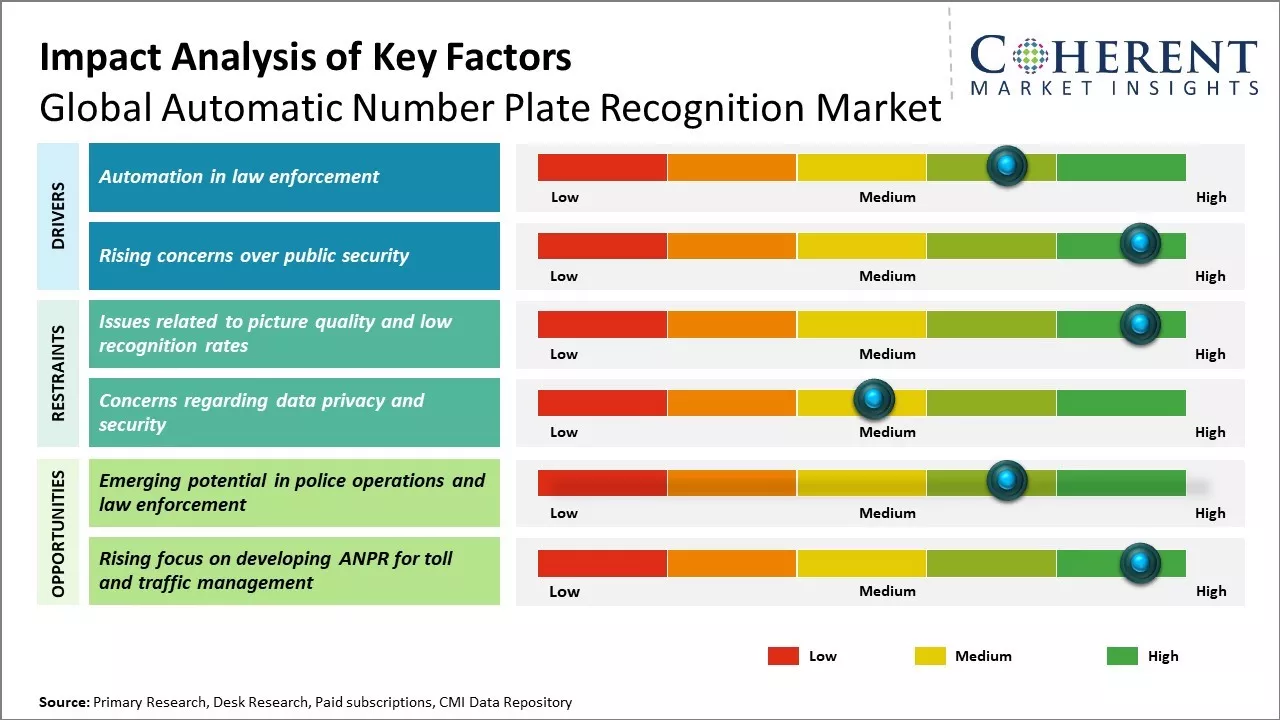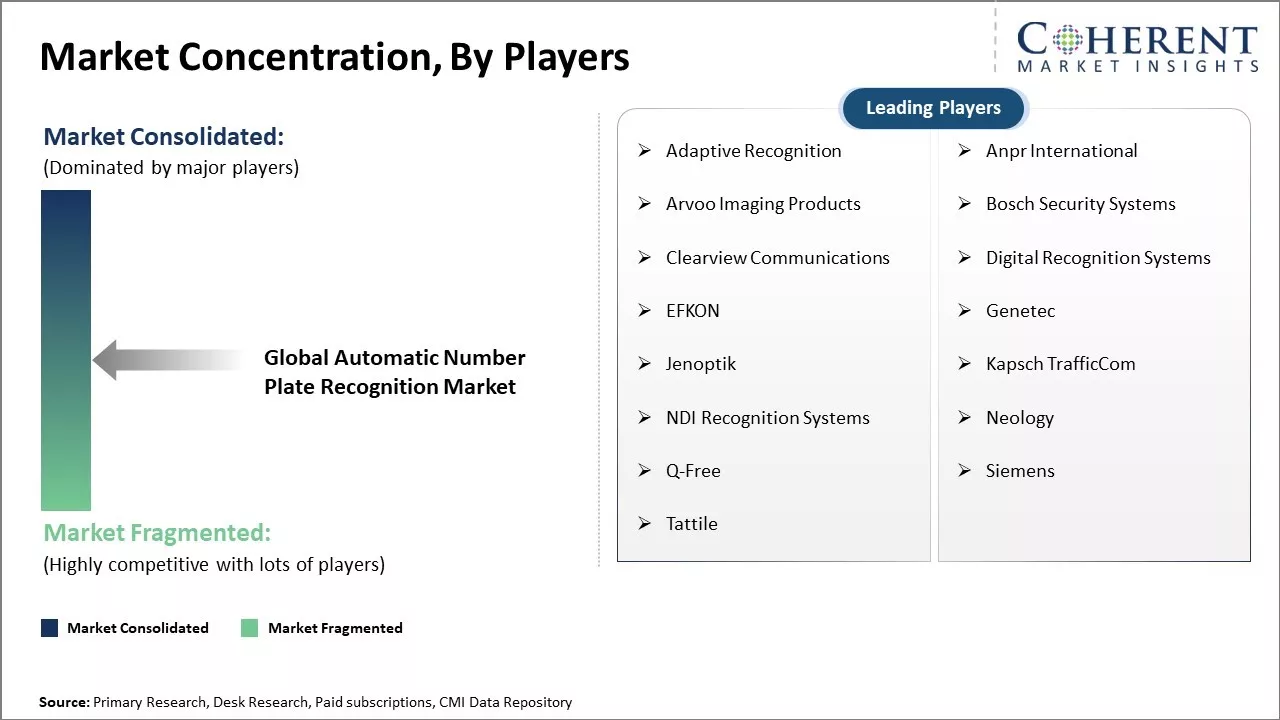The global automatic number plate recognition market is estimated to be valued at USD 50.71 Bn in 2025 and is expected to reach USD 111.47 Bn by 2032, exhibiting a compound annual growth rate (CAGR) of 11.9% from 2025 to 2032.

To learn more about this report, Download Free Sample
The Automatic Number Plate Recognition (ANPR) Market is experiencing strong growth, driven by rising demand for intelligent traffic solutions and enhanced security systems. Rising security concerns and growing rate of security camera installation in residential and commercial areas will drive demand for ANPR market. The ability of this system to monitor the entry and exit of vehicles will increase their adoption across various applications such as parking management, traffic management, and law enforcement.
|
Current Event |
Description and its impact |
|
Technological Advancements and System Innovations |
|
|
Strategic Collaborations and Market Penetration |
|
|
Policy Reforms and Surveillance Mandates |
|
Uncover macros and micros vetted on 75+ parameters: Get instant access to report
With advanced technologies automating many tasks, police departments across the globe are looking towards innovative solutions to increase their effectiveness. Automatic number plate recognition systems allow law enforcement to easily track vehicles of interest without much human intervention.
The automated optical character recognition capabilities of ANPR take license plate reading to a new level of accuracy and efficiency. With alerts triggered whenever watch-listed vehicles are identified, authorities can focus their efforts on verified leads. This streamlines investigations and allows scarce police resources to be directed towards more valuable tasks.
As criminal networks expand their operations internationally, the ability to rapidly identify foreign vehicles in jurisdiction becomes critical. ANPR automates this process and improves border security surveillance capabilities.
In July 2025, Delhi Police announced that it would integrate Automatic Number Plate Recognition (ANPR) technology into its e‑Beat Book mobile application. This upgrade will link CCTV cameras with vehicle databases, enabling real‑time scanning, identification of stolen vehicles, suspect tracking, and reconstruction of escape routes within hours streamlining criminal investigations and enhancing operational effectiveness.
As urbanization increases worldwide, megacities face mounting challenges in ensuring residents feel safe and protected. High population densities mean more vehicles crowding city streets, making it difficult for police to manually record all license plates. ANPR helps address this issue by providing round-the-clock monitoring of vehicle movements.
Stolen cars and vehicles involved in crimes can be identified in real-time. This acts as a powerful deterrent against criminal plans. Additionally, lost or missing persons can now be located quicker if their vehicle license plate number is available.
For municipalities, ANPR expands the effectiveness of surveillance networks to enhance public safety. It offers reliable alerts on suspicious activity patterns and blacklisted participants. In an age of growing security threats, governments and law enforcement agencies are under increasing pressure to deploy innovative solutions. ANPR appears well-suited to meet this need.
In late July 2025, the Madurai city police inaugurated AI‑powered ANPR cameras at the Theni Road check post, with three cameras activated at key junctions. The cameras, linked to the city's command centre and NIC, facilitate automatic detection of traffic violations, generate challans, capture driver images, and help identify stolen vehicles. Plans are underway to expand the network to 15 locations.
The use of automatic number plate recognition (ANPR) technology by law enforcement agencies around the world presents a significant opportunity for the global Automatic Number Plate Recognition market to grow. ANPR systems help modern police forces optimize their operations and improve public safety through more efficient and data-driven policing methods.
As populations rise and urbanization increases the challenges of law enforcement, ANPR provides cost-effective solutions to issues like tackling crime, managing traffic flows and responding to emergencies. Police are able to monitor vehicle movements across wide areas, detect stolen vehicles and identify those being driven without registration or insurance. This allows them to deploy patrol resources more strategically. ANPR also deters criminal activity as perpetrators know their vehicle's location can be tracked.
Looking ahead, the ability to link number plate data to other police databases offering intelligence on persons of interest, outstanding warrants and watched addresses means ANPR has future potential to transform proactive policing. Its integrated use for joint operations between different law enforcement divisions, such as drug enforcement, organized crime and missing persons’ investigations offers better collaboration opportunities.

To learn more about this report, Download Free Sample
Fixed Automatic Number Plate Recognition (ANPR) systems are projected to capture approximately 61.8% of the global ANPR market share in 2025. This segment’s dominance is driven by continuous advancements in imaging technologies such as high-resolution infrared cameras, rapid-processing units, and AI-powered plate recognition algorithms. These systems are ideally suited for stationary setups at toll booths, traffic lights, and secure entry points delivering consistent, round-the-clock performance in both urban and highway environments.
Among the most prominent Automatic Number Plate Recognition use cases, fixed ANPR systems stand out for their enhanced accuracy under varying weather and lighting conditions, making them indispensable for traffic enforcement, toll collection, and urban surveillance.
As smart city initiatives expand globally, fixed ANPR systems are increasingly deployed for real-time traffic monitoring, vehicle tracking, and security compliance. Their robust performance and integration with intelligent transportation systems continue to reinforce their long-term growth potential in the market.
The traffic management application segment is anticipated to secure 43.3% of the ANPR market share in 2025. This growth is largely attributed to the increasing deployment of ANPR solutions for dynamic vehicle monitoring, congestion mitigation, and traffic rule enforcement. These systems enable real-time data collection and analysis for speed tracking, red-light violation detection, and route optimization, thereby supporting intelligent transportation systems.
Municipalities and transport authorities are actively integrating ANPR with AI, IoT, and cloud platforms to enhance road safety, reduce manual intervention, and improve urban mobility. As cities become more congested and governments shift toward digital infrastructure for traffic oversight, the demand for ANPR in traffic management is poised for significant expansion.
The government sector is projected to dominate end-user adoption in the ANPR market, accounting for 55% of the global share in 2025. This leadership stems from the increasing focus on national security, border surveillance, and urban safety measures. Public authorities are investing heavily in ANPR deployment across highways, toll plazas, restricted zones, and border checkpoints to facilitate real-time vehicle identification, blacklisting, and criminal investigations.
As threats to public security rise and law enforcement operations become more data-driven, ANPR systems offer a powerful and scalable solution. With initiatives promoting smart governance and digital infrastructure, government agencies are prioritizing ANPR technologies for proactive monitoring and compliance, solidifying their position as the primary end-user segment in the market.

To learn more about this report, Download Free Sample
North America is poised to lead the global Automatic Number Plate Recognition (ANPR) market in 2025, capturing approximately 38.8% of the total market share. This dominance is underpinned by early adoption of intelligent traffic management technologies, robust infrastructure, and significant government investment in public safety initiatives.
The United States, in particular, has witnessed widespread Automatic Number Plate Recognition implementation across law enforcement agencies, border control operations, and urban surveillance networks. These systems are increasingly integrated with advanced analytics, real-time data sharing platforms, and nationwide security frameworks to enhance monitoring and enforcement capabilities.
The region benefits from a strong ecosystem of leading ANPR technology providers, regulatory compliance standards, and favourable funding policies that encourage innovation and scalability. Municipalities and state governments continue to invest in upgrading legacy traffic systems with AI-powered ANPR solutions to support crime prevention, toll collection, and smart city initiatives.
As smart mobility and urban digitization efforts accelerate, North America is expected to maintain its leadership in ANPR adoption and innovation through 2025 and beyond.
The United States leads the global Automatic Number Plate Recognition (ANPR) market, contributing significantly to North America’s projected 38.8% market share in 2025. Its leadership is driven by large-scale deployment of ANPR systems across federal and local law enforcement, border control, and smart city surveillance projects.
With robust investments in digital infrastructure and public safety technology, the U.S. has integrated ANPR into traffic management, toll collection, and vehicle tracking solutions nationwide. The presence of key ANPR solution providers and a strong regulatory framework for data security further reinforce the country’s dominance. Ongoing innovations in AI-powered analytics and cloud-based ANPR platforms continue to enhance system efficiency and real-time enforcement capabilities.
Canada plays a pivotal role in the North American ANPR market, benefiting from strong government support, advanced urban infrastructure, and a commitment to road safety and surveillance modernization. ANPR systems are increasingly used across Canadian provinces for automated tolling, red-light enforcement, and vehicle compliance monitoring.
Government initiatives focused on smart transportation and secure border management have fuelled the adoption of ANPR technologies. Furthermore, collaboration between provincial transportation agencies and private vendors ensures scalable deployments. Canada’s emphasis on data privacy, combined with rising urban mobility challenges, supports its expanding contribution to the global ANPR landscape.
| Report Coverage | Details | ||
|---|---|---|---|
| Base Year: | 2024 | Market Size in 2025: | USD 50.71 Bn |
| Historical Data for: | 2020 To 2024 | Forecast Period: | 2025 To 2032 |
| Forecast Period 2025 to 2032 CAGR: | 11.9% | 2032 Value Projection: | USD 111.47 Bn |
| Geographies covered: |
|
||
| Segments covered: |
|
||
| Companies covered: |
Adaptive Recognition, Anpr International, Arvoo Imaging Products, Bosch Security Systems, Clearview Communications, Digital Recognition Systems, EFKON, Genetec, Jenoptik, Kapsch TrafficCom, NDI Recognition Systems, Neology, Q-Free, Siemens, and Tattile |
||
| Growth Drivers: |
|
||
| Restraints & Challenges: |
|
||
Uncover macros and micros vetted on 75+ parameters: Get instant access to report
*Definition: The global automatic number plate recognition market consists of companies that develop software and hardware systems for automatic optical character recognition of vehicle registration plates. The ANPR systems use camera and pattern recognition software to capture images of license plates from a distance. They convert the images of license plate characters into alphanumerical data that can integrate with various law enforcement, electronic toll collection, and traffic management systems. ANPR technology helps in enforcing traffic rules, combating crime and terror threats, and managing electronic tolls across borders.
Share
Share
About Author
Monica Shevgan has 9+ years of experience in market research and business consulting driving client-centric product delivery of the Information and Communication Technology (ICT) team, enhancing client experiences, and shaping business strategy for optimal outcomes. Passionate about client success.
Missing comfort of reading report in your local language? Find your preferred language :
Transform your Strategy with Exclusive Trending Reports :
Frequently Asked Questions
Joining thousands of companies around the world committed to making the Excellent Business Solutions.
View All Our Clients